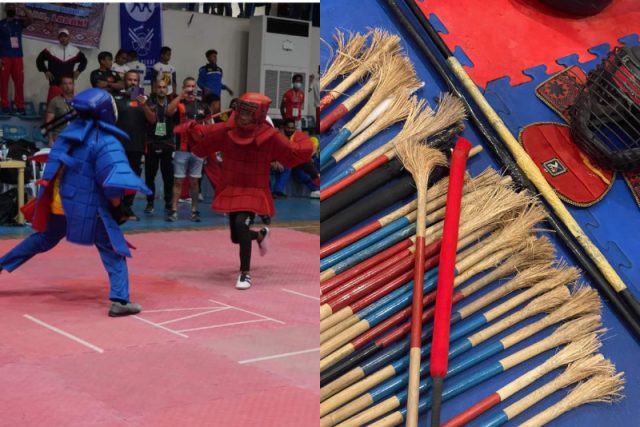
Are stick fights painless? Two world champions showed their bruises as proof that no one is left unscathed even with maximum protection.
Southeast Asian Games silver medalist Jude Rodriguez and national team athlete Jordan Cruz posted videos of their “battle scars” on Facebook, after their respective matches at the 16th World Eskrima Kali Arnis Federation (WEKAF) World Championships in Mandaue City, Cebu on Thursday, July 21.
“#WEKAF fights are “painless,” Rodriguez said in a post on Facebook showing a bruise on her arm.
“ #WEKAF fights are ‘painless (2),’ “ Cruz said, echoing Rodriguez on a Facebook post showing his bruises.
Both videos have a combined 1,314 views as of writing.
Through the years, martial arts critics on online forums point out the lack of the “pain factor” in arnis competition due to the heavy protection gear each player wears during matches.
They claimed that the “heavily padded” armor lessens the “risk factor” of the sport compared with other martial art.
Every match requires each competitor to wear approximately eight kilograms of protection. It comprises a helmet, an upper body kimono-like armor, a groin guard, an arm and leg guard, and padded gloves – which almost cover every inch of their body.
“The only people who say that are the ones who have never really fully immersed themselves in this type of sport sparring format,” Cruz, referring to the people who said arnis competitions are without scathe, said in an interview with Interaksyon.
Cruz got most of his bruises in his championship match for “bangkaw” or long staff category against USA’s Richard Coley.
Bangkaw is played by hitting the opponent continuously with a five-foot-long staff, for three rounds, each lasting a minute.
Rodriguez, meanwhile, said that the pain from the bruises she got while playing single and double live sticks, where she both won a gold medal, was felt the day after the tournament.
“My bruises do [not] hurt, it [is] the body pain the day after that you wake up with. Somehow you just feel like a giant bruise waddling around saying ‘ow’ everytime you lift a limb,” she said in an interview.
“I can’t even pinpoint the pain because it [is] everywhere from my neck, to my back, to my shoulders and muscles that I did [not] think I was even using,” Rodriguez added.
The live stick format has the same format as bangkaw, but opponents hit each other with either one or two rattan sticks.
Rodriguez, together with Annjeanette Brillantes and Kate Iccy Solis, are the top players in the competition. Each bagged three gold medals and one silver.
Cruz, on the other hand, won two gold medals and two silver medals.
This is their second world title for Arnis.
Hazard-reduction
Like any combat sport, bruises and injuries are inevitable.
A long-time arnis coach clarified that the armor used for live sticks does not guarantee a person of total protection from bruises or injuries but just puts the hazard on the lowest level.
“The kimono armor is not meant to zero-out injury, it [is]going to reduce its possibility of creating a debilitating injury, your injuries can still happen because [the strikes] will provide feedback,” Nathan Espino, an arnis coach in four different schools in NCR, said in an interview.
“We want the injury to provide feedback but not to the point that it becomes life-threatening career-threatening or livelihood-threatening,” he added.
He said that the armor is used to protect a person from strikes above and from the side, but pressed some strikes may still make contact with the body.
“Any side coming from the bottom such as a potential ‘otso’ or a well-placed ‘banda,’ can still evade especially also depending on the position of the body…there is always a possibility that it will evade and still make contact with the body,” he said.
“Otso,” from the Spanish word for the number eight, is a strike usually used in live stick matches where they hit their opponent from the bottom going upward like writing the number eight in the air.
“Banda” meanwhile is a side-to-side strike where one swings their stick from left to right.
Arnis was declared the country’s national sport in 2009 replacing sepak takraw or “sipa.” The sport was officially included in the Southeast Asian Games in 2005, the third time the Philippines hosted the regional tournament.
The Philippines, composed of athletes from the Philippine National Arnis Team and other local teams dominated the 16th WEKAF Championships from July 17 to 21, reaping 149 gold medals, 139 silver medals, and 138 bronze medals.
RELATED: Philippines dominates arnis world championship





